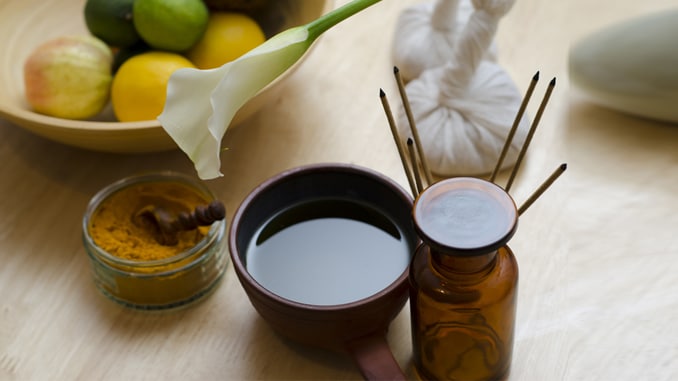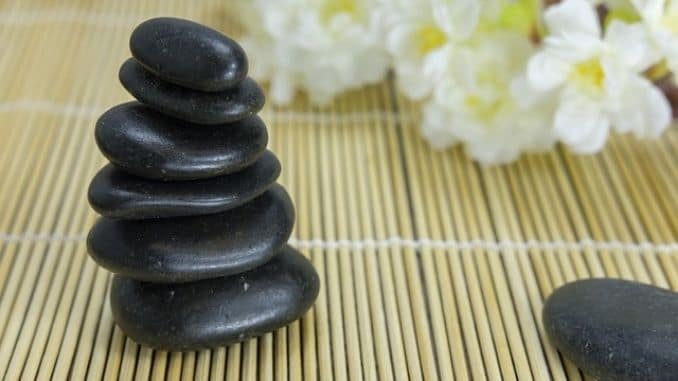
Herbal medicines, yoga, and meditation have all gained popularity worldwide during the past few decades as treatments for certain health problems. Interestingly enough, Ayurvedic medicine uses all of these tools to help prevent and treat illnesses and promote optimal wellness.
In fact, several media reports show an increasing demand for Ayurvedic treatments, particularly as consumers become more aware of this unique practice.
What is Ayurvedic medicine and might it be beneficial for you?
Where Did Ayurveda Come From?
Ayurveda, or Ayurvedic medicine as it’s also called, is an ancient system of traditional medicine that evolved in India and has survived for centuries. Like other societies and cultures that developed natural remedies for common illnesses, the Indian people had their remedies too, based on a logical understanding of human nature that hasn’t changed in thousands of years. In fact, Ayurveda is considered one of the oldest systems of traditional medicine still accepted worldwide today.
The story goes that about 5,000 years ago, the ancient seers of India received the gifts of Ayurveda from their Hindu gods. Then, they recorded the information on how to achieve a healthy and balanced life in several sacred texts. In time, Indian methods of healing acquired depth and reasoning, and the current texts of Ayurveda came into being. Between 320 to 550 A.D., they were further refined into what remains as their current form.
As the years passed and civilizations changed, Western medicine gained prominence, and Ayurveda went through a period where it was seen as quackery, particularly when the British ruled India. It survived in rural areas where people maintained traditional ways of living. Later, as India regained its independence, the practice experienced a resurgence.
More recently, in the mid- to late-20th century, Western healers took a renewed interest in Ayurveda and traveled to India to learn more about it. Doctors and practitioners brought those teachings back to the United States. When Indian-born alternative medicine advocate Deepak Chopra published “Perfect Health: The Complete Mind/Body Guide,” he brought Ayurvedic medicine into the mainstream.
How Does Ayurvedic Medicine Work?
The word Ayurveda is made up of two Sanskrit terms: Ayur means life and Veda means science or knowledge. The basic concept is that all areas of life impact one’s health. Rather than look at one thing that might be causing disease, Ayurvedic practitioners tend to look at the whole picture — the individual, lifestyle and environment.
The logic of Ayurveda says that the universe is composed of five elements:
- Air (vayu)
- Water (jala)
- Space (aakash)
- Earth (prithi)
- Fire (teja)
These five elements together form three basic humors of the human body. The term “humors” in ancient medicine refers to the makeup and workings of the human body. In Ayurveda, the three humors are:
- Vata dosha (air + space)
- Pitta dosha (fire + water)
- Kapha dosha (earth + water)
“Dosha” refers to the energy circulating in the body. These three doshas, together called the “tridoshas,” are responsible for all functions in the body.
Each person is born with a unique mix of the three doshas, with each representing a different combination of the five elements. Optimal wellness is achieved when there is a balance between all three. The disease is thought to occur when there is an imbalance in the one or more of the doshas, interrupting energy flow.
Those seeking to use Ayurveda in achieving wellness need to know first, their specific Ayurvedic constitution — which doshas are strongest in them — and then to understand their current state of balance. Knowledge of these two things allows one to make informed decisions about diet, activity and other lifestyle elements that can help keep the doshas in balance and contribute to overall good health.
The Three Doshas
To understand Ayurvedic medicine better, we need to understand the three doshas.
1. Vata (Air + Space)
This dosha is connected to the wind and is always moving and dynamic. The main qualities are dry, light, cool, rough, subtle and mobile. It’s related to things that move in the body, such as blood flow and air, and thus is connected to circulation and respiration.
Those who are dominant in vata and are in balance are lively and energetic, quick-thinking, thin and fast. They are often creative with an active fantasy life with an ability to get a lot done or to multitask.
When vata is unbalanced, the individual is susceptible to anxiety, dry skin, and hair, muscle wasting, underweight, nervousness and constipation.
2. Pitta (Fire + Water)
This dosha is high in qualities like heat, oiliness, light, strength, spreading and liquid. It’s related to digestion, hormones, and metabolism.
Those dominant in pitta are intelligent, intense, goal-oriented and strong-willed. They may have soft skin but may also suffer from acne. They are natural leaders and quick learners, with fiery personalities, but they can be judgmental or impatient with others who are less focused than they are.
When pitta is unbalanced, the individual is susceptible to grumpiness, irritability, obsessed behavior, hot-temperedness, heartburn and ulcers.
3. Kapha (Earth + Water)
This dosha is high in qualities like coolness, heaviness, slow pace, softness, denseness and stability. It’s related to strength, immunity and growth, affecting the chest, lungs and spinal fluid.
Those dominant in kapha have solid body frames and are laid back with a cool temperament. They have big hearts and find it easy to sympathize with others. They are seen as stable and loyal members of the family or community and tend to be strong with good stamina. They may be naturally athletic. They like having a regular routine in life and at work and don’t care for change.
When kapha is unbalanced, the individual is susceptible to gaining weight, stubbornness, diabetes and getting stuck in unhealthy patterns.
Determining Your Dosha
There are many tests available online to help you determine which dosha tends to be dominant in you. Most people, interestingly enough, share qualities strongly with two doshic types and are said to have dual constitutions. You may be vata-pitta, for example, or pitta-kapha. Ayurvedic practitioners typically recommend managing the two by season, emphasizing one in the fall and the other in the spring.
Some people can also have equal amounts of each dosha influencing them. They are called “tri-doshic,” and are said to be very strong and adaptable when in balance. When out of balance, they can experience very poor health. Ayurvedic practitioners usually advise these types to be aware of changes in their environments to detect potential imbalances.
Does Ayurvedic Medicine Work?
Ayurvedic remedies typically include herbal medicines, meditation and yoga, massage, diet, and aromatic oils. The goal of treatment is to attain balance among the doshas. The first step is to prevent problems in the first place by eating the right diet for your dosha and to adopt other lifestyle habits that support its balance.
Ayurveda says that our dominant dosha is the easiest one to grow out of proportion. A pitta person, for example, is naturally fiery and busy. However, if these qualities grow too much, the person may become burned out. So, when the disease is present, practitioners suggest decreasing the excess dosha by providing opposite qualities.
For the burned-out pitta, coolness and softness are likely remedies to help calm the fire. That means cool foods, drinks, environments, and herbs, with treatments possibly including gentle massage, melodic music, cooling herbs like Brahmi and Guduchi and soothing yoga moves.
Whenever disease or ill health is present, remedies such as those mentioned above are used to help the person regain balance and wellness. As to whether these remedies work, scientists are still studying them but, so far, the results look promising.
The National Center for Complementary and Integrative Health (NCCIH) states that a few well-designed clinical trials and study reviews suggest that Ayurvedic approaches can be effective. In a 2013 trial, researchers compared two Ayurvedic formulations of plant extracts against the natural joint pain remedy glucosamine and the drug celecoxib in 440 people suffering from knee osteoarthritis. All four products provided similar reductions in pain and improvements in function.
An earlier 2011 study also compared the drug methotrexate against an Ayurvedic treatment ― a combination of 40 herbal compounds ― for rheumatoid arthritis and found that both were effective.
Another small, short-term trial suggested that an Ayurvedic herb formulation may help lower blood sugar in people with type 2 diabetes, but scientists say we need more research to be sure. Turmeric, an herb popular in Ayurvedic medicine, has also been found in studies to be an effective anti-inflammatory as well as potentially helping with ulcerative colitis.
So far, however, most of the studies have been small, and we need more evidence to back up the efficacy of Ayurvedic remedies. Current studies are underway testing Ayurvedic medicines for breast cancer survival and arthritis as well as other inflammatory diseases.
Is Ayurvedic Medicine Safe?
There have been reports of some Ayurvedic medicines containing toxic compounds that can be harmful to health.
In 2008, the U.S. Food and Drug Administration (FDA) warned that according to a study published in the Journal of the American Medical Association (JAMA), one-fifth of U.S.-manufactured and Indian-manufactured products purchased on the Internet contained detectable lead, mercury or arsenic.
Out of 193 bought online, nearly 21 percent had detectable levels of these potentially dangerous ingredients. The researchers concluded that several Indian-manufactured products could result in lead or mercury ingestions 100 to 100,000 times greater than acceptable safety limits.
The FDA urged consumers to use caution when purchasing these products on the Internet and, to be aware that Ayurvedic products, do not undergo FDA review before they are put on the market. You can look for the traditional herbal registration (THR) mark or symbol on the packaging, which signifies the product uses only registered herbal products tested for quality and safety.
In addition, there is no significant regulation of Ayurvedic practice or education in the U.S. and no state requires licensing for practitioners. Certain practices that are part of Ayurveda, including emesis and blood cleansing, are highly controversial and may be unsafe.
If you would like to try Ayurvedic medicine, the most important thing is to find a qualified practitioner and to use caution with any products you buy. The National Ayurvedic Medical Association in the U.S. does provide an Ayurvedic professional directory. However, these professionals aren’t required to have any particular certification.
It would also be wise to check with your doctor before taking any Ayurvedic herbal formulations to ensure they won’t harm you or interfere with any other medications you may be taking.
For your guide to the best foods to heal your body, check out The Best Foods that Rapidly Slim & Heal in 7 Days, here!

